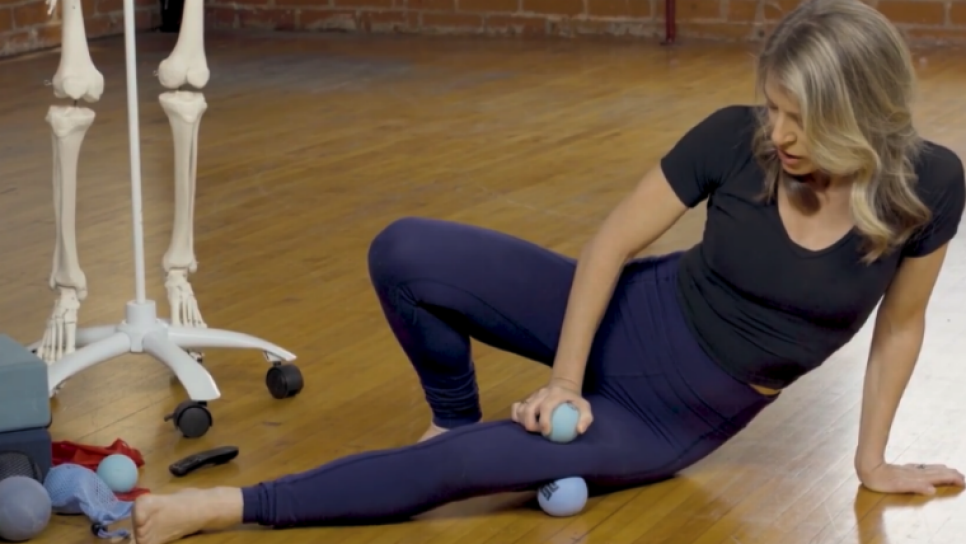Feeling sore? Here’s everything you need to know about foam rolling – Australian Golf Digest

- by Admin
- July 5, 2024

A study published in the science journal NeuroQuantology concluded that if you foam roll for less than 30 seconds on any particular muscle group, you’re pretty much wasting your time. In fact, the good stuff really doesn’t kick in until you’re rolling a spot for 90 seconds (three sets of 30 seconds). File that nugget away the next time you’re thinking of improving your mobility.
Want to know more about foam rolling? Introducing Jill Miller. She’s a nationally known expert on yoga, breathing and the soft tissue that plays a monster roll in how you swing a golf club—fascia. If you’re not familiar with the term, fascia is the internal connective tissue that surrounds, interweaves and interpenetrates all organs, muscles, bones and nerve fibers. If that sounds important, well, it is.
Fascia gives the body structure and provides all internal systems a way to operate in an integrated manner. It greatly impacts a person’s strength, mobility, coordination and ability to heal. It’s composed of fibers, cells, fluids and nerves and its collagen fibers, which lengthen and recoil, are largely responsible for a person’s dynamic mobility. Fascia also serves as a portal for healing agents and is part of the inflammatory processes and the immune system.
We could go on, but you get the point. Taking care of your fascia is just as important, if not more, than working on your muscle fiber.
Jill Miller (below), who has written several books on health and fitness including her most recent, Body by Breath, has some advice if you’ve tried foam rolling (self-myofascial release) or are now considering it as a way to address soreness, fatigue, muscle activation, etc. Miller has lectured hundreds of fitness professionals on this topic, including as part of Golf Digest’s Certified Fitness Trainer curriculum, and she wants you to consider these eight “commandments” before you get busy.
MORE: Cut your workout time in half with these great exercises
1. “Find tools that actually feel good on your body,” Miller says. “Soft tools like squishy foam rollers and soft pliable balls actually have an ‘edge’ over harder tools that might look like they belong on a 4X4. A harder tool initiates the ‘muscle-bracing response,’ which is your nervous system’s way of defending your body if it senses that an object is threatening your tissues. Rolling while wincing is not necessarily therapeutic. Find a tool that helps you soften your body, rather than rolling up to a battle.”
2. “Roll prior to your round of golf,” Miller says. “Research shows that it improves your overall coordination, decreases pain and improves muscle force production on the tissues you’ve rolled. You’ll generate more power in your swing.”
3. “Also roll after your game. Research demonstrates a reduction in DOMS (delayed onset muscle soreness) and improved relaxation, which can help you sleep better. Great news if you’re playing again tomorrow.”
4. “Roll your feet before and after lacing up. Golf shoes can be restrictive, especially in the front of the foot. Use a ball to stimulate all 26 bones and the dozens of muscles of your feet pre and post play—especially if you mostly walk and carry. As a bonus, rolling can reduce swelling that accumulates in the ankles after a long day on your feet.”
5. “Back pain can be eliminated. Rolling isn’t the only thing to address back pain, but it sure helps to improve mobility between vertebral segments that are stiff or limited. Rolling up and down along the spine and then carefully across the muscles of your back can improve function in every plane of motion for your spine.”
6. “Thinking of paying for a massage? Save your dollars. Rolling is much more cost-effective than relying on others to address aches and pains. Rolling is also available on demand, whenever and wherever you ‘knead’ it. Get it?”
7. “Rolling improves your nervous system, transforming you from wound up and anxious (sympathetic) to a more mellow and calm state (parasympathetic). This can be helpful for improved decision-making and overall cognitive function, especially on the back nine when you get mentally tired.”
8. “Roll like the wind, so to speak. Rolling around your core, rib cage and back can improve your range of respiration and the mobility and contractility of the muscles that control your breathing. These breath muscles are also a superpower for your swing.”
MORE: How I lost 23 pounds in a year—downing burgers, pizza and playing a little golf
This article was originally published on golfdigest.com
The Latest News
-
November 15, 2024Australian bounce India’s arch-enemy amid KL Rahul dilemma
-
November 15, 2024Nick Kyrgios set to make long-awaited return to tennis as comeback date revealed
-
November 15, 2024List wins elusive DP World Tour card, Barron loses his
-
November 15, 2024India great warns ‘the king is back in his territory’ as struggling Virat Kohli returns for fifth tour
-
November 15, 2024‘Adaptable’ Murphy spins out WA to put Vics in control | cricket.com.au





